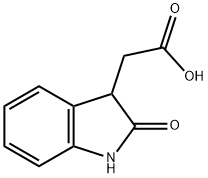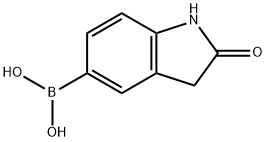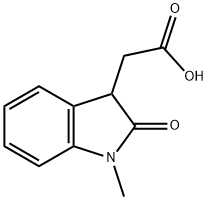2-oxindole-3-acetic acid
- CAS NO.:2971-31-5
- Empirical Formula: C10H9NO3
- Molecular Weight: 191.18
- MDL number: MFCD09035909
- SAFETY DATA SHEET (SDS)
- Update Date: 2023-05-15 10:43:52

What is 2-oxindole-3-acetic acid?
The Uses of 2-oxindole-3-acetic acid
Oxindole-3-acetic Acid is a derivative of Indoleacetic Acid (I577340) is the most common and naturally occurring plant hormone in the auxin class of hormones. It effects cell elongation, cell division as well as plant growth and development.
Definition
ChEBI: 2-oxindole-3-acetic acid is a member of the class of oxindoles that is 2-oxindole carrying a carboxymethyl substituent at position 3. It has a role as a plant metabolite. It is a monocarboxylic acid, a member of indole-3-acetic acids and a member of oxindoles. It is a conjugate acid of a 2-oxindole-3-acetate. It is a tautomer of a 2-hydroxy-(indol-3-yl)acetic acid.
Properties of 2-oxindole-3-acetic acid
| Melting point: | 218-219 °C |
| Boiling point: | 445.2±38.0 °C(Predicted) |
| Density | 1.334±0.06 g/cm3(Predicted) |
| storage temp. | Sealed in dry,Store in freezer, under -20°C |
| solubility | DMSO (Slightly), Methanol (Slightly) |
| form | Solid |
| pka | 4.21±0.10(Predicted) |
| color | Off-White to Pale Brown |
Safety information for 2-oxindole-3-acetic acid
| Signal word | Warning |
| Pictogram(s) |
 Exclamation Mark Irritant GHS07 |
| GHS Hazard Statements |
H302:Acute toxicity,oral H312:Acute toxicity,dermal H332:Acute toxicity,inhalation |
| Precautionary Statement Codes |
P261:Avoid breathing dust/fume/gas/mist/vapours/spray. P264:Wash hands thoroughly after handling. P264:Wash skin thouroughly after handling. P270:Do not eat, drink or smoke when using this product. P271:Use only outdoors or in a well-ventilated area. P280:Wear protective gloves/protective clothing/eye protection/face protection. P330:Rinse mouth. P363:Wash contaminated clothing before reuse. P301+P312:IF SWALLOWED: call a POISON CENTER or doctor/physician IF you feel unwell. P302+P352:IF ON SKIN: wash with plenty of soap and water. P304+P340:IF INHALED: Remove victim to fresh air and Keep at rest in a position comfortable for breathing. P501:Dispose of contents/container to..… |
Computed Descriptors for 2-oxindole-3-acetic acid
New Products
4-AMINO-TETRAHYDRO-PYRAN-4-CARBOXYLIC ACID 4-Aminotetrahydropyran-4-carbonitrile Hydrochloride (R)-3-Aminobutanenitrile Hydrochloride 4-AMINO-TETRAHYDRO-PYRAN-4-CARBOXYLIC ACID HCL 1,4-Dioxa-8-azaspiro[4.5]decane 5-Bromo-2-nitropyridine SODIUM AAS SOLUTION ZINC AAS SOLUTION BUFFER SOLUTION PH 10.0(BORATE) GOOCH CRUCIBLE SINTERED AQUANIL 5 BERYLLIUM AAS SOLUTION INOSITOL PANTOPRAZOLE SODIUM SESQUIHYDRATE Metformin FLUCLOXACILLIN SODIUM STERILE NIMESULIDE BP ZONISAMIDE 1,1-Dimethylethyl 4-(2-azidoacetyl)-1-piperidinecarboxylate 2-Bromo-1-(bromomethyl)-3-iodo-5-nitrobenzene 1,2-Dibromo-3-(bromomethyl)-5-nitrobenzene 2-Cyano-5-pyrimidineacetonitrile 7-Fluoro-4-cinnolinamine 2-Bromo-1-(bromomethyl)-3-chloro-5-nitrobenzeneRelated products of tetrahydrofuran

![SPIRO[1,3-DIHYDRO-2H-INDOL-2-ONE-3,7'-(ETHYL 5'-AMINO-6'-CYANO-2'-[(Z)-2'-METHOXY-2'-OXOETHYLIDENE]-3'-OXO-7H-[1',3']THIAZOLO[3',2'-A']PYRIDINE-8'(3H)-CARBOXYLATE)]](https://img.chemicalbook.in/StructureFile/ChemBookStructure8/GIF/CB6308742.gif)



![5-Spiro(N-acetyl-2-oxoindan-3-yl)-[3,4-d]succinic anhydride-N-acetyl-4,5-dihydrobenzo[cd]indol-2(1H)-one](https://img.chemicalbook.in/)


You may like
-
 Oxindole-3-acetic acid 95% CAS 2971-31-5View Details
Oxindole-3-acetic acid 95% CAS 2971-31-5View Details
2971-31-5 -
 (2-Oxo-2,3-dihydro-1H-indol-3-yl)acetic acid CAS 2971-31-5View Details
(2-Oxo-2,3-dihydro-1H-indol-3-yl)acetic acid CAS 2971-31-5View Details
2971-31-5 -
 1823754-06-8 98%View Details
1823754-06-8 98%View Details
1823754-06-8 -
 2-Chloro-5-(iodomethyl)pyrimidine 2268818-88-6 98%View Details
2-Chloro-5-(iodomethyl)pyrimidine 2268818-88-6 98%View Details
2268818-88-6 -
 2092793-98-9 98%View Details
2092793-98-9 98%View Details
2092793-98-9 -
 1360944-55-3 7-Methoxy-1H-indol-5-amine 98%View Details
1360944-55-3 7-Methoxy-1H-indol-5-amine 98%View Details
1360944-55-3 -
 2090480-14-9 98%View Details
2090480-14-9 98%View Details
2090480-14-9 -
![1-Methyl 2-bromo-5-[(1-carboxy-1-methylethyl)amino]benzoate 1651844-56-2 98%](https://img.chemicalbook.in//Content/image/CP5.jpg) 1-Methyl 2-bromo-5-[(1-carboxy-1-methylethyl)amino]benzoate 1651844-56-2 98%View Details
1-Methyl 2-bromo-5-[(1-carboxy-1-methylethyl)amino]benzoate 1651844-56-2 98%View Details
1651844-56-2
Statement: All products displayed on this website are only used for non medical purposes such as industrial applications or scientific research, and cannot be used for clinical diagnosis or treatment of humans or animals. They are not medicinal or edible.